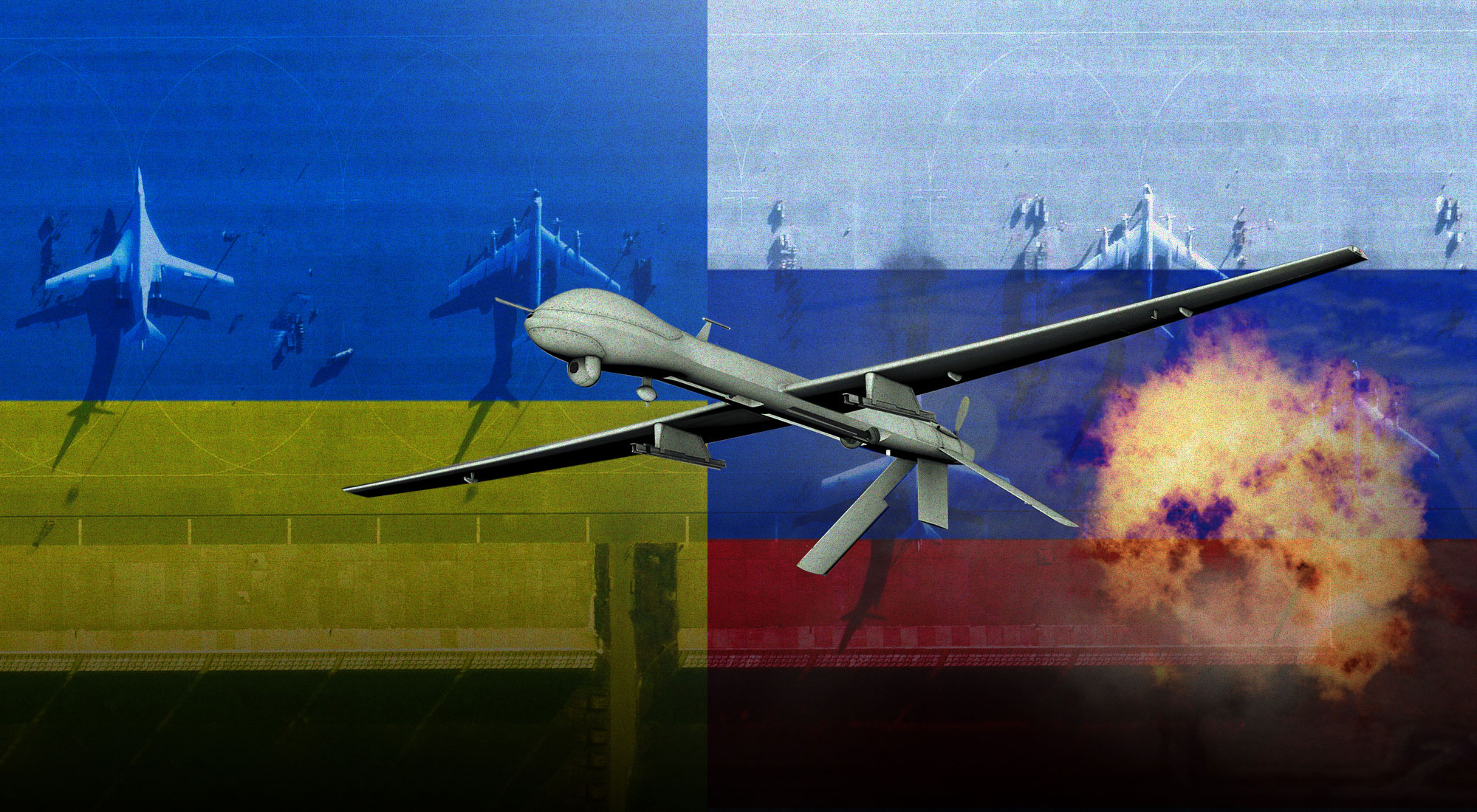The deadly attack on an industrial area near Abu Dhabi National Oil Company storage facility and at another on an under-construction extension to Abu Dhabi International Airport, on January 17 serves as a stark and tragic reminder of the escalating threat posed by unmanned aerial systems in the possession of the Iranian-led radical axis.
The attack, for which the Yemeni Houthis claimed responsibility, killed three and caused explosions in petroleum tankers caused by a fire at the Mussafah industrial complex, and a separate fire at the airport extension in the Emirati capital. [1]
A Houthi spokesperson claimed the attack used a combination of Samad 3 drones and Quds 2 cruise missiles, although the types of weapons used in the attack are yet to be verified at the time of this writing.
The Houthis have fired Samad 3 explosive drones at Saudi Arabia from Yemen repeatedly in the past, including one in March 2021 [2] and another in January 2022 [3], with Saudi air defenses intercepting the threats. According to initial reports that still require confirmation, the drones used in the attack on January 17 were fired from Yemeni territory.
Israel has named the Samad 3 variant as a version of the Iranian KAS-04 UAV, saying that this family of UAVs is made by Iran’s Kimia Part Sivan Company (KIPAS). According to Israeli sources, this weapon system has a range of 1700 kilometers – placing Abu Dhabi in range from parts of Yemen. A similar type of UAV infiltrated Israeli airspace in May 2021 from Iraq, flying over Jordan into Israel, before the IAF shot it down. [4]
The distance from Yemen to Abu Dhabi would suggest that fixed-wing long-range UAVs were used. Despite their long-range capabilities, such systems often fly slow and at low altitude, making their detection a challenge for timely radar detection.
Iran itself has also been making increasing usage of such systems, including to strike moving maritime targets, such as the deadly attack on the civilian Mercer Street tanker on July 29 – 30 2021, which killed two crew members on-board. [5]
Some of these fixed-wing UAVs are suicide drones, crashing into their targets with precision and detonating their warhead on impact, while others are capable of dropping air-to-ground munitions. Others are designed to conduct intelligence-gathering flights.
Under the generic category of ‘drone’ exist two broad categories of threats. The first is that of fixed-wing military UAVs, which are generally larger types of drones in the possession of Iran and several non-state radical actors in the Middle East, such as the Houthis, Hamas, and Hezbollah, the latter of which is estimated to possess 2,000 UAVs. [6] Hezbollah and the Houthis have imported drones directly from Iran. [7] In addition, Hamas in Gaza has its own drone manufacturing industry which relies on Iranian instruction and know-how.
The other broad type of system involves commercial drones, generally quadcopters, used for hostile intent by adversaries. These form useful shorter-range tools for intelligence-gathering and can also be used for kinetic strikes [7]. In Syria, ISIS pioneered the use of commercial drones to drop explosives on targets, while in Western cities, they have been used to disrupt airports merely by flying into restricted air spaces.

Source: Courtesy of the Alma Research and Education Center Report “Iran’s UAE Army-A Global Threat”

Source: Courtesy of the Alma Research and Education Center Report “Iran’s UAE Army-A Global Threat”
According to Brigadier General (Res.) Shachar Shohat, the former commander of the Israeli Air Defense Forces from 2012 to 2015, non-state hostile actors are increasingly using drones to help “level the playing field against their enemies,” forming a kind of air force with its own precision strike capabilities. [8]
Every non-state terrorist group and guerrilla force can arm itself “with an accurate aerial weapon and use it to attack its target of choice. So far, the world has been slow to respond,” wrote Shohat. “This has given the non-state actors their own kind of air force, with the ability to gather intelligence, drop bombs and communicate beyond line of sight—all for a low price.”
When it comes to operating commercially-made drones, it takes almost no time for anyone, including hostile actors, to learn how to use these intuitive systems. Operating military-grade UAVs is often significantly more complex and requires varying degrees of prior training. To that end, Iran has established regional training centers in which it trains its proxy forces on how to operate UAVs. Examples include the UAV training center in the Iraqi Karbala desert, which has a 300-meter runway, and where the Iranian Quds Force, which arms, trains, and funds Tehran’s proxies, has worked with Hezbollah experts to provide training courses lasting between 30 to 45 days. [9]
Additionally, Israeli Defense Minister Benny Gantz stated last year that Iran is training proxies to operate advanced UAVs at its Kashan Base, located north of Isfahan. [10]
According to Gantz, the center is used to train operatives from Iraq, Yemen, Lebanon, and Syria, and is also teaching them how to manufacture Iranian drones.
The threat posed by fixed-wing UAVs and smaller drones casts a shadow on the security of Israel and Gulf states. Saudi Arabia has been a regular target of such attacks from Yemen, as the 2019 drone strike on Aramco oil sites at Abqaiq-Khurais demonstrated – an attack that temporarily reduced Saudi Arabia’s oil output by half.
Israel too has in recent years found itself increasingly targeted by UAVs and drones operated by Iran, its proxies, and its allies. This includes an attempt by Iran to transfer TNT to an armed cell in the West Bank via a UAV flown from Syria. [11]
The threat of swarms of drones attacking sensitive national sites means that weapons now form a strategic rather than merely a tactical threat.
This threat is becoming more acute as Iran’s Islamic Republican Guards Corps (IRGC) grows more dominant in Iran’s regional malign activity, at the expense of the Quds Force. While the Quds Force has traditionally served as the overseas clandestine unit of the IRGC, responsible for both delivering capabilities to proxies and activating offensive capabilities throughout the Middle East, since the assassination of Quds Force Commander Qassem Soleimani in January 2020, the IRGC, an elite military force that runs parallel to the regular Iranian Armed Forces, and which enjoys significantly better resources, has stepped up its direct involvement in force activation in the Middle East.
The IRCG, which has its own elite air force, navy, and ground forces, brings with it more advanced UAV capabilities, as it scores points in a kind of internal competition between it and the Quds Force.
Affected countries are in a race against time to procure a range of air defense systems.
Some systems are designed to deal with large UAVs, some with smaller drones, while others can take on both.
The UAE, for example, is replacing its MIM-23 Hawk air defense system with the South Korean-made M-Sam system as a medium-range defense layer, which operates below the UAE’s Patriot surface-to-air missiles.
The UAE has fielded Patriot systems since 2009, and these contain long-range interceptors designed to take on ballistic missiles, cruise missiles, and advanced aircraft. In 2019, the U.S. approved sales of upgraded PAC-3 Patriot systems to the UAE.
The South Korean-made M-Sam system is designed for medium-range threats flying at medium and low altitudes, and should be able to also take on larger UAVs. [12] This may not however necessarily close the vulnerability gap regarding some smaller, lower-flying, slower-moving unmanned aerial systems, although the system might be able to undergo adjustments to enable it to do so.
Currently, the UAE uses a mix of Russian-made Pantsir gun and missile systems and Swiss-made Skyguard (Oerlikon) gun systems for these short-range air defense requirements.
Smaller unmanned aerial systems ideally require short-range air defense systems to engage them – systems that are specifically designed for lower altitude and slower-moving threats, both in terms of having the ability to detect them through radar and electro-optic sensors designed to detect lower, slower targets, classifying them in time, and deploying the appropriate countermeasures, capable of neutralizing the threat without using highly expensive interception missiles.
Small, affordable short-range interceptors and laser interception systems appear to be the way forward.
The increase in the threat posed by UAVs and smaller drones means that the world needs to return to focusing on developing and acquiring short-range (SHORAD) air defense systems. Iron Dome, for example, can detect threats at short ranges of 3.5 kilometers. [13]
In Israel, the air force has developed early detection capabilities, diversified its interception options, and set as a goal the ability to shoot them down as they enter borders (unless the IAF deliberately allows it to fly into Israel to gather further intelligence on it before intercepting it). This includes shooting down UAVs with air-to-air missiles fired with fighter jets, and using Rafael’s Iron Dome air defense system to neutralize the threat, as first occurred in May 2021. [14] This capability is further complimented by the ground-based laser interception system being developed in Israel by Elbit, Rafael, and the Israeli Defense Ministry, which should be operational by 2025, and be able to shoot down threats at a range of eight to ten kilometers away, as a complimentary air defense layer to Iron Dome. [15]
Hamas launched six drones during its May conflict with Israel, and the IDF intercepted all of them, using a combination of F-16 jets and Iron Dome interceptions to do so.
Israeli defense companies have, meanwhile, been developing a range of counter-drone and UAV systems, taking advantage of years of experience in advanced radar detection abilities, command and control technology, jamming, and the increasing use of hard kill options, such as laser cannons.
For example, Rafael’s Drone Dome system is able to engage both larger fixed-wing UAVs and smaller drones.
In its product description, Rafael described Drone Dome as an effective way to conduct airspace defense “against hostile drones used by terrorists and criminals to perform aerial attacks, collect intelligence and carry out intimidating activities.” [16]
Rafael described its product as “an end-to-end solution, providing soft and hard-kill, 360-degree circular coverage, with a quick response time and a high success rate while inflicting minimal collateral damage.”
In 2018, British security forces deployed Drone Dome to Gatwick Airport, ending a 36-hour period of disruption to air traffic following the presence of unauthorized drones. [17]
According to Meir Ben Shaya, Business Development Senior Director at Rafael’s Air and Missile Defense Systems Division, four layers are needed to deal effectively with modern drone threats: detection, identification, neutralization, and now, thanks to laser technology, a hard-kill option for clients who need it. [18]
Drone Dome uses a combination of radar, signals intelligence (SIGINT), and an electro-optic sensor to detect threats in the air, with the ability to detect small targets up to 3.5 kilometers away.
Multiple sensors create a unified air situational picture, enhanced by artificial intelligence, which can distinguish and identify targets.
For a soft kill, it deploys its jammer, which blocks the signal and commands communication to and from the remote control, the video transmission from the drone to the operator, and the drone’s satellite signal access, causing it to destabilize.
In its laser-based intercept configuration, “the laser director receives the target position from the C4I [command, control, communications, computers, and intelligence], which allocates it to the laser effector. The effector then locks and tracks the target, and within a few seconds, the laser beam is transmitted and destroys the target,” according to Rafael.
Israel Aerospace Industries-Elta’s Drone Guard can also engage a variety of unmanned aerial system types, depending on the type of hard kill interceptor requested by clients.
It employs an Active Electronically Scanning Phased Array (AESA) radar and electro-optic sensors guided by radar indications to detect and track targets – including fixed wing UAVs, up to 4.5 kilometers away.
For a soft kill, it uses a directional jammer, and for a hard kill, IAI collaborated with the Iron Drone company to offer clients the option of striking threats with an interception drone. [19]
Elbit’s Redrone, meanwhile, in its various configurations, is designed to protect borders, airports, seaports, strategic facilities, military bases, and others, from the threat posed by a variety of unmanned aerial systems, ranging from low-cost commercial drones and quadcopters to UAVs.
It uses radar, Sigint, electro-optic and infrared, acoustic, and cyber sensors, “all integrated on an open, unified platform and run from a single control station,” according to Elbit. [20]
Following detection, “the system blocks all radio communication channels and GNSS signals,” and disrupts the drone’s command and control link using a radio frequency transmitter that works while minimizing the “risk of collateral damage.”
In November 2021, the Moroccan military announced that it had procured the Israeli Skylock anti-drone system. [21]
As the Abraham Accords develop, and each side views one another’s comparative advantage, cooperation between Israel and Gulf states could extend to significant capability sharing, including in the field of anti-drone defense systems.
Alongside this potential for cooperation, every country that is under the U.S. Military’s Central Command (CENTCOM) area of responsibility, and which has the ability to detect, track, and intercept large UAVs and smaller drones, can boost cooperation to make future interception efforts more effective.
Like the threat of cruise missiles and precision guided ballistic projectiles in the wrong hands, UAVs and smaller drones are here in the region to stay. The threat they pose can only be expected to increase with time, particularly when examining the potential for future swarm attacks. Ultimately, these emerging – and significant – threats require increasingly advanced short-range air defense capabilities, and systems equipped with radars, electro-optical sensors, and processing abilities that are able to detect the lower flying, slower-moving threats in time to respond effectively.
In addition, all affected nations in the region have a clear interest in cooperating with one another to boost regional security.
References
[1] Charbel Mallo and Celine Alkhaldi, 2022. 3 killed in suspected Houthi drone attack in Abu Dhabi, CNN, https://edition.cnn.com/2022/01/17/middleeast/uae-abu-dhabi-explosion-drone-houthi-intl/index.html
[2] Al-Arabiya News, 2021. Video shows 2 Iran-made ‘Samad’ drones launched by Houthis toward Saudi Arabia, Al Arabiya, https://english.alarabiya.net/News/gulf/2021/03/07/Video-shows-2-Iran-made-Samad-drones-launched-by-Houthis-toward-Saudi-Arabia
[3] Mahmut Geldi, 2022. Saudi air defense intercepts 3 Houthi drones, Anadolu Agency, https://www.aa.com.tr/en/middle-east/saudi-air-defense-intercepts-3-houthi-drones/2463665
[4] Jeremy Binnie, Israel identifies Iran’s ‘deniable’ UAV, 2021. Jane’s, https://www.janes.com/defence-news/news-detail/israel-identifies-irans-deniable-uav
[5] United States CENTCOM, 2021. Iranian UAV Attack on M/T Mercer Street, USCENTCOM, https://www.centcom.mil/Portals/6/PressReleases/MERCERSTREETATTACK06AUG2%20final.pdf
[6] Tal Beeri, 2021. An estimation of the number of UAVs used by Hezbollah – Research Logic, Alma Center, https://israel-alma.org/2021/12/23/an-estimation-of-the-number-of-uavs-used-by-hezbollah-research-logic/
[7] Tomer Barak, 2021. A change is needed in the U.S. Approach to the Yemen War, The Miryam Institute, https://www.miryaminstitute.org/commentary-blog/a-change-is-needed-in-the-us-approach-to-the-yemen-war
[8] Yaakov Lappin, 2017. Israel Faces a Growing Enemy Drone Threat, Begin-Sadat Center for Strategic Studies, https://besacenter.org/israel-enemy-drones/
[9] Tal Beeri, 2021. Iran’s “UAV Army” – A global threat. Alma Center, https://israel-alma.org/wp-content/uploads/2021/12/Irans-UAV-Army-%E2%80%93-A-Global-Threat.pdf
[10] Anna Ahronheim, 2021. Jerusalem Post, Iran training terror groups to operate advanced UAVs, https://www.jpost.com/middle-east/iran-training-terror-groups-to-operate-advanced-uavs-679242
[10] Brig. (res.) Shachar Shohat, 2018. Commercial drones: A clear and growing threat to our skies, Times of Israel, https://blogs.timesofisrael.com/commercial-drones-a-clear-and-growing-threat-to-our-skies/
[11] Judah Ari Gross, 2021. Gantz exposes Iran drone bases, says Tehran tried to fly TNT into West Bank via UAV, Times of Israel, https://www.timesofisrael.com/gantz-exposes-iran-drone-bases-says-tehran-tried-to-fly-tnt-via-uav-into-west-bank/
[12] Brig. Gen. (res). Shachar Shohat, 2020. Short-range air defense is making a comeback, Defense News, https://www.defensenews.com/opinion/commentary/2020/09/18/short-range-air-defense-is-making-a-comeback/
[13] Jeremy Binnie, 2021. UAE announces South Korean M-SAM order, Jane’s, https://www.janes.com/defence-news/news-detail/uae-announces-south-korean-m-sam-order
[14] Seth J. Frantzman, 2021. Iron Dome intercepts drone during combat for first time, says Israeli military, Defense News, https://www.defensenews.com/unmanned/2021/05/17/iron-dome-intercepts-drone-during-combat-for-first-time-says-israeli-military/
[15] Yaakov Lappin, 2020. Israel announces laser breakthrough, Jane’s, https://www.janes.com/defence-news/news-detail/israel-announces-laser-breakthrough
[16] Rafael, 2021. DRONE DOME™ – C-UAS, Rafael website, https://www.rafael.co.il/worlds/air-missile-defense/c-uas-counter-unmanned-aircraft-systems/
[17] Simon Griver, 2018. UK army deploys Rafael’s Drone Dome at Gatwick airport, Globes, https://en.globes.co.il/en/article-uk-army-deploys-rafaels-drone-dome-at-gatwick-airport-1001265876
[18] Yaakov Lappin, 2021. Growing role, and complexity, of lasers to combat drone threats, JNS, https://www.jns.org/the-growing-role-and-complexity-of-lasers-in-combating-drone-threats/
[19] IAI Press Release, 2020. IAI and Iron Drone Collaborate to Integrate Interception Capabilities into IAI’s anti-drone system, Drone Guard, IAI, https://www.iai.co.il/iai-and-iron-drone-collaboration
[20] Elbit, accessed 2022. ReDrone, https://elbitsystems.com/media/ReDrone.pdf
[21] Agnes Halou, 2021. Defense News, https://www.defensenews.com/unmanned/2021/11/24/morocco-buys-israeli-counter-drone-system-skylock-dome/








